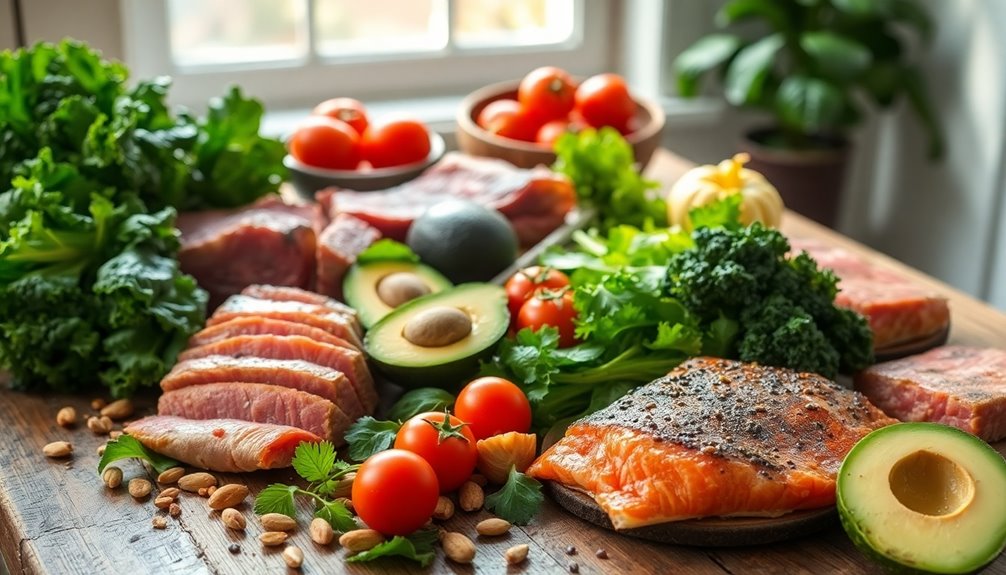The Paleo Diet is all about embracing the eating habits of our ancient ancestors. You'll focus on whole, unprocessed foods like lean meats, fish, fruits, and vegetables while avoiding grains and processed items. This approach can help with weight management, improve digestion, and boost your energy levels. It promotes a sustainable lifestyle and connects you with nutrient-dense options to enhance your overall health. Meal planning and community support make it easier to stick to the Paleo principles. If you're curious about practical tips and personal experiences related to the Paleo lifestyle, there's plenty more to discover!
Key Takeaways
- The Paleo Diet focuses on whole, unprocessed foods, prioritizing lean meats, fish, fruits, vegetables, nuts, and seeds for optimal health.
- Benefits include weight loss, improved digestion, increased energy, better mood, and strengthened immunity through nutrient-dense food choices.
- Meal planning is essential; gather recipes, focus on fresh produce, and consider batch cooking to maintain a sustainable diet.
- Challenges include navigating social gatherings, communicating dietary choices, and finding compliant meal options while traveling or dining out.
- The Paleo Diet can be budget-friendly by prioritizing seasonal and local produce, avoiding processed foods, and planning meals effectively.
What Is the Paleo Diet?
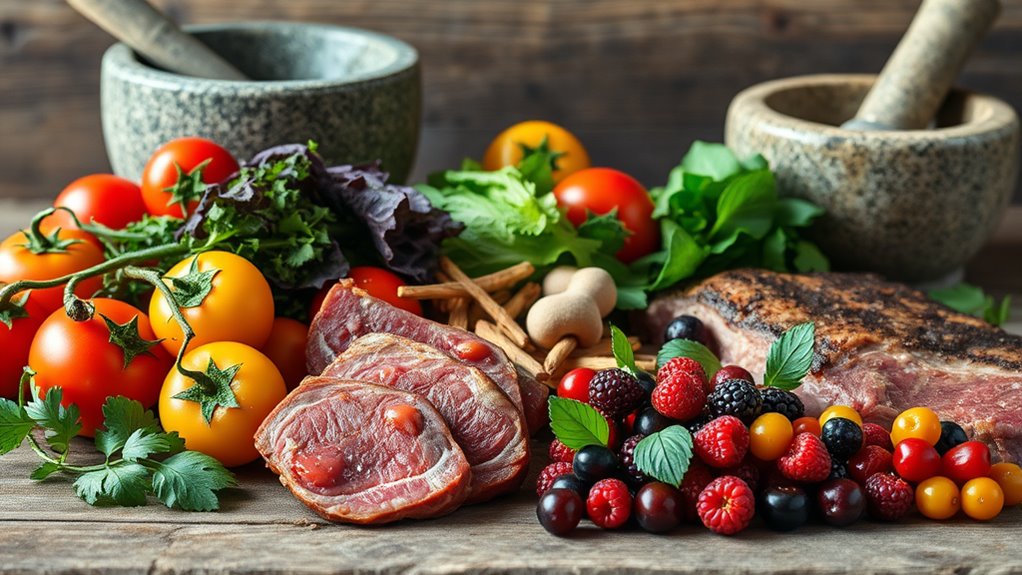
The Paleo diet, often referred to as the "caveman diet," is based on the idea of eating like our ancient ancestors. By embracing an evolutionary approach, you're connecting with a time when our forebears thrived on whole, unprocessed foods. Imagine gathering around a fire, sharing meals of wild game, fresh fruits, vegetables, and nuts—this is the essence of the Paleo lifestyle. It's not just about food; it's about belonging to a community that values health and a return to simplicity.
In this modern adaptation of ancient eating habits, you'll find that the Paleo diet encourages you to ditch processed foods, sugars, and grains. Instead, you'll focus on nutrient-dense options that nourish your body and keep you energized.
You might feel a sense of camaraderie with others who share the same journey, as you swap recipes and tips on how to prepare tasty, wholesome meals. Moreover, many individuals who adopt a plant-based diet experience improved overall health as they transition to more nutrient-rich foods.
As you explore the Paleo diet, you'll discover that it's more than just a way to eat; it's a lifestyle that promotes well-being and connection. By choosing to eat like our ancestors, you're honoring their wisdom while fostering a sense of community with like-minded individuals. This journey can lead to healthier choices and a deeper appreciation for the food you consume.
Key Principles of the Paleo Diet
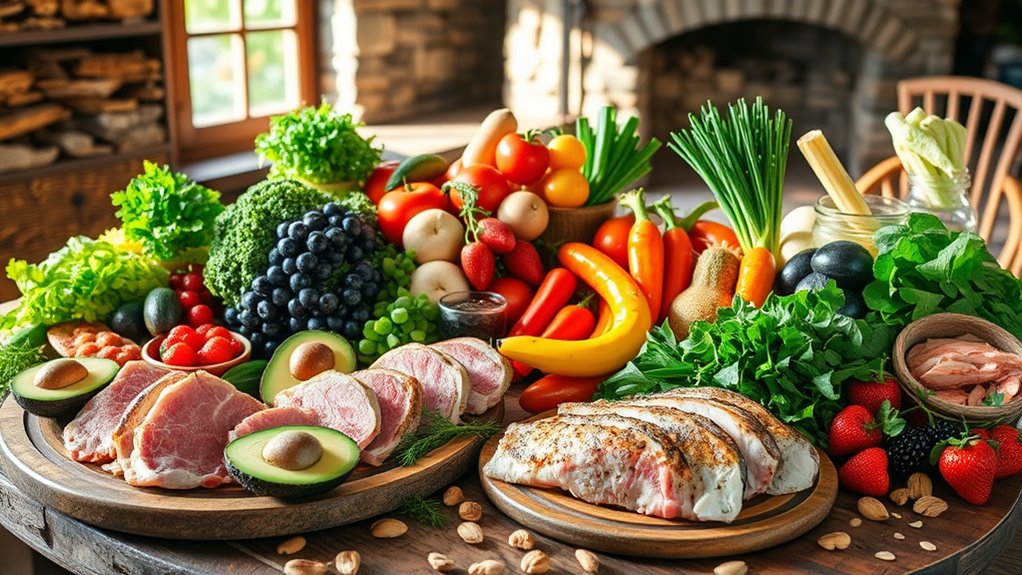
Embracing the Paleo diet involves understanding its key principles, which guide your food choices and lifestyle. At its core, the Paleo diet focuses on reverting to a way of eating that our ancestors thrived on. This means prioritizing whole, unprocessed foods that provide nutritional balance. You'll want to fill your plate with lean meats, fish, fruits, vegetables, nuts, and seeds, steering clear of refined sugars and grains. This approach not only nourishes your body but also fosters a sense of community as you connect with others who share your commitment to wholesome eating.
Another principle of the Paleo diet is embracing a sustainable lifestyle. It's about making conscious choices that can be maintained over the long term. This means considering the origins of your food and how it impacts both your health and the environment. By opting for organic and locally sourced options whenever possible, you contribute to a more sustainable food system.
Furthermore, embracing the Paleo lifestyle encourages you to be mindful of your overall well-being. Regular physical activity, sufficient sleep, and stress management complement the diet and enhance your health. As you engage with others on this journey, you'll likely find a supportive community that shares your values and goals, making the shift smoother and more enjoyable. Additionally, incorporating exercise methods like mini band workouts can enhance muscle tone and support your overall fitness goals.
Incorporating these principles into your life can lead to lasting changes, helping you feel more connected to your food, your health, and those around you.
Foods to Include
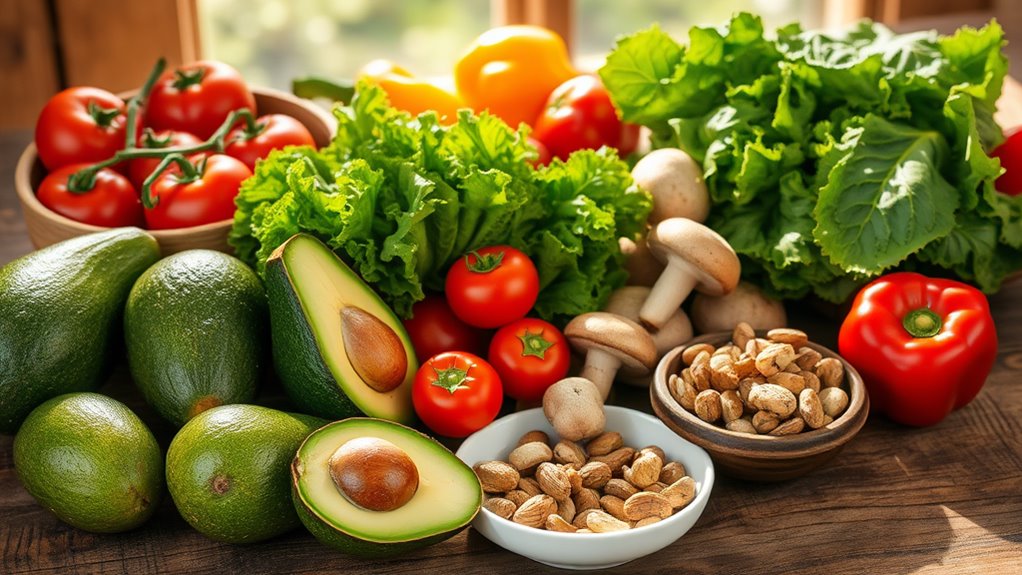
When following the Paleo diet, knowing which foods to include makes a significant difference in your success. You'll want to focus on whole, unprocessed foods that our ancestors would have eaten. Start by filling your plate with plenty of fresh vegetables. Leafy greens, broccoli, and bell peppers aren't just nutritious; they're also versatile. You can roast them, toss them in salads, or use them in stir-fries.
Next, incorporate high-quality proteins. Grass-fed meats, wild-caught fish, and free-range poultry pack a punch in terms of nutritional benefits. They provide essential amino acids and healthy fats that keep you energized. For recipe suggestions, try grilling chicken thighs with a mix of herbs and spices or baking salmon with lemon and dill.
Don't forget healthy fats! Avocados, nuts, and seeds are great options. They not only boost flavor but also contribute to heart health and satiety. You can whip up delicious smoothies with almond milk, spinach, and a banana, or make a snack of apple slices smeared with almond butter. Additionally, incorporating whole-food sources of protein into your meals can enhance overall nutrition and support energy levels.
Lastly, include fruits moderately. Berries, apples, and bananas are excellent choices, offering natural sweetness along with vitamins and antioxidants. You can enjoy a bowl of mixed berries for breakfast or a banana with nuts for a quick snack.
Foods to Avoid

Avoiding specific foods is vital for successfully following the Paleo diet. To truly embrace this lifestyle, you'll need to be mindful of what you put on your plate.
First and foremost, it's pivotal to cut down on sugar intake. Refined sugars and sweeteners found in processed foods can disrupt your body's natural balance and lead to cravings that make it hard to stick to your goals. Instead, focus on natural sources like fruits when you need a sweet fix.
Next, you'll want to prioritize grains elimination. Grains, including wheat, rice, and corn, aren't part of the Paleo approach. They can cause inflammation and interfere with digestion for many people. By avoiding these, you'll feel lighter and more energized in your daily life. Additionally, grains like wheat are associated with chronic health risks that can hinder your overall wellness.
Dairy products are another area to reconsider. While some may tolerate them, many find that cutting out dairy helps reduce bloating and discomfort.
Don't forget about processed foods. These often contain hidden sugars, unhealthy fats, and preservatives that go against the very essence of the Paleo diet.
Potential Health Benefits

Cutting out processed foods, sugar, grains, and dairy can lead to a range of potential health benefits that many people experience on the Paleo diet. You might find yourself feeling more energized, enjoying better digestion, and even shedding those extra pounds. The focus on whole foods like lean meats, fruits, and vegetables can create a satisfying and nourishing diet that aligns with your wellness goals. Additionally, eliminating processed foods from your diet can significantly enhance your overall health and well-being.
Here's a quick look at some of the benefits you might experience:
| Health Benefit | Description | Potential Impact |
|---|---|---|
| Weight Loss Benefits | Reducing carbs and sugar can help you shed unwanted pounds. | Improved confidence and energy. |
| Improved Digestion | A diet high in fiber from fruits and veggies supports gut health. | Less bloating and discomfort. |
| Increased Energy | Whole foods fuel your body better than processed ones. | Enhanced daily performance. |
| Better Mood | Nutrient-rich foods can positively affect your mood. | Enhanced emotional well-being. |
| Strengthened Immunity | Nutrient-dense foods boost your immune system. | Fewer illnesses and better health.
Common Myths Debunked
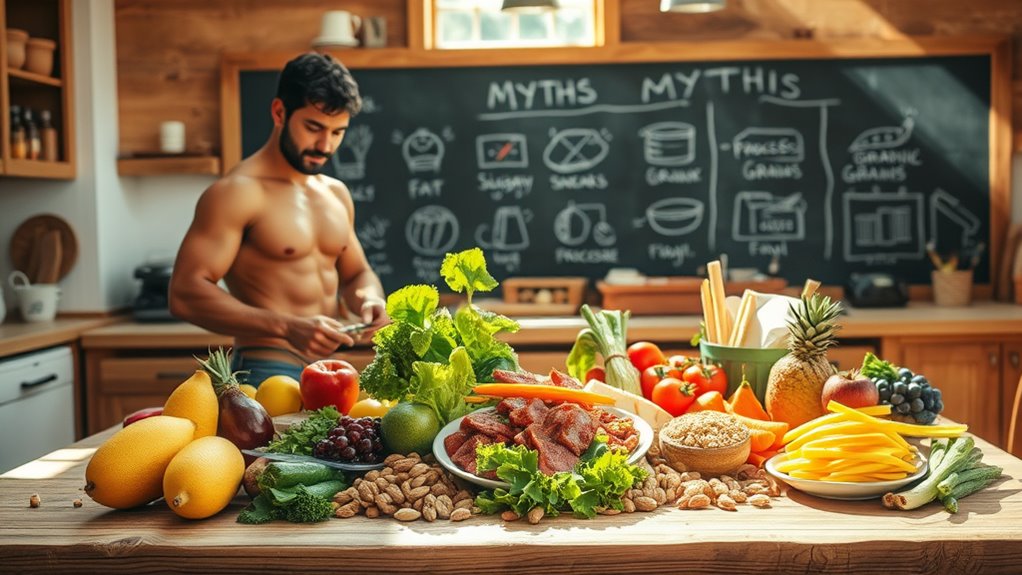
Many people believe common myths about the Paleo diet that can cloud its true benefits. One prevalent myth is that the diet lacks nutritional balance. In reality, when you focus on whole foods—like vegetables, fruits, lean meats, and nuts—you'll find it's quite possible to achieve a well-rounded intake of essential nutrients. You don't have to cut out entire food groups; instead, you're encouraged to choose high-quality, nutrient-dense options that nourish your body.
Another misconception is that the Paleo diet isn't a sustainable lifestyle. Many think it's too restrictive, but that's not the case. Once you embrace the principles of the diet, it can be surprisingly flexible. You can adapt it to fit your preferences and needs, making it easier to stick with in the long run. Plus, by focusing on foods that are in line with what our ancestors ate, you're likely to build healthier habits that promote longevity and well-being. Additionally, following natural eating patterns like The Gen can further enhance your health and weight management.
Lastly, some people argue that the Paleo diet is expensive, but with some planning, you can make it work within your budget. Prioritizing seasonal and local produce often leads to savings, proving that a healthy diet doesn't have to break the bank.
Meal Planning Tips
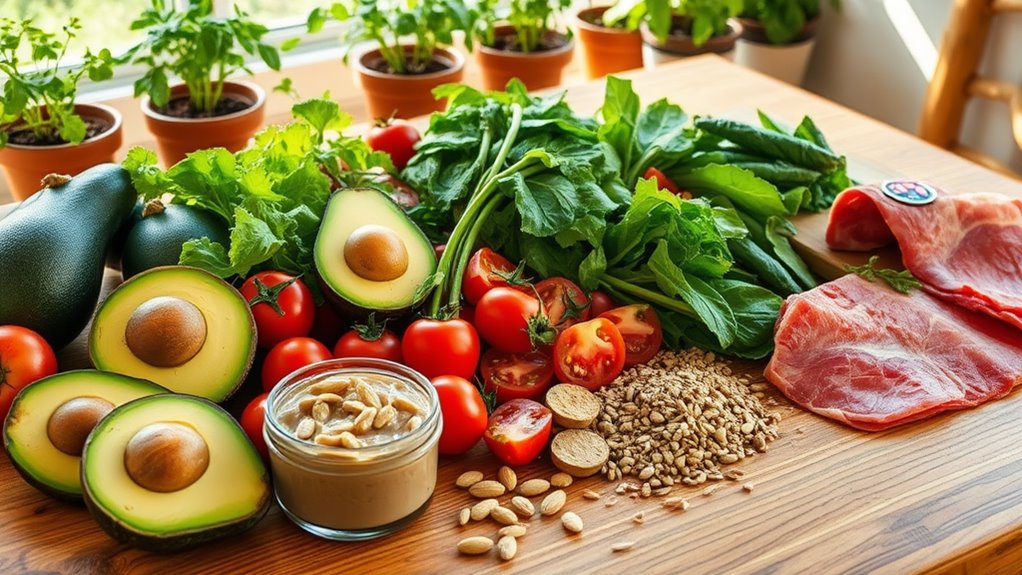
Meal planning can be your secret weapon for successfully following the Paleo diet. It helps you stay organized and guarantees you have delicious, nutritious meals ready to go. To start, gather some recipe ideas that excite you. Think about meals you love, and then adapt them to fit the Paleo framework. Simple dishes like grilled chicken with roasted veggies or a hearty beef stew can easily be made Paleo-friendly.
Next, make a list of your favorite ingredients and plan your meals around them. This won't only save you time but also keep your grocery shopping focused and efficient. When you hit the store, stick to the perimeter where fresh produce, meats, and seafood are typically found. Avoid processed foods in the aisles, as they often don't align with your Paleo goals.
Consider batch cooking on weekends. Preparing several meals at once means you'll have ready-to-eat options throughout the week. You can also create a rotating menu to keep things interesting and prevent boredom.
Don't hesitate to swap out ingredients based on what's in season or on sale. Flexibility is key, and it fosters creativity in the kitchen. By sharing your meal plans and recipe ideas with others, you can build a sense of community and support, making the journey more enjoyable. Remember, meal planning isn't just about food; it's about cultivating a lifestyle that nourishes both your body and spirit. Additionally, incorporating smoothie recipes can provide a quick and nutritious meal option that aligns with your dietary preferences.
Challenges and Considerations
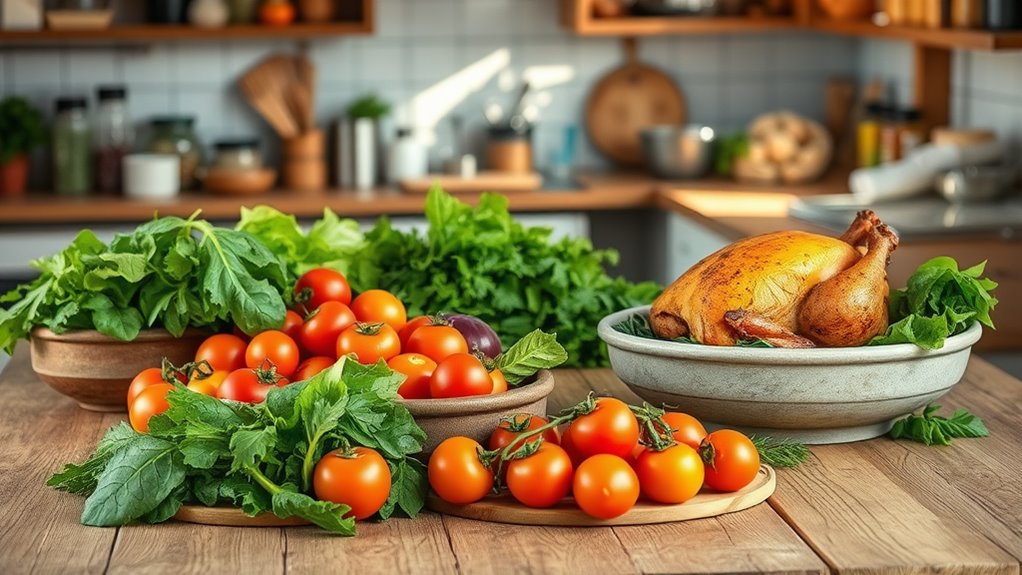
Exploring the Paleo diet can present several challenges that require careful consideration. One of the biggest hurdles you might face is maneuvering social gatherings. Whether it's a friend's barbecue or a family reunion, the temptation of non-Paleo-friendly foods can be strong. You'll need to be prepared to make choices that align with your goals while still enjoying time with loved ones.
Communicating your dietary choices to friends and family can also help you feel supported instead of isolated.
Traveling and dining out can add another layer of complexity to your Paleo journey. When you're on the move, finding compliant options can be tricky. Many restaurants don't cater specifically to Paleo diets, and you might find yourself staring at a menu filled with temptations. But don't let that deter you! A little planning goes a long way. Researching restaurants in advance and even calling to ask about ingredient options can help.
Additionally, it's important to remember that you don't have to be perfect. Life is about balance, and sometimes you might choose to indulge, even if it's not strictly Paleo. Embracing flexibility can make your journey feel more sustainable and less restrictive. Ultimately, it's about finding what works for you while still feeling connected to those around you. With a proactive approach, you can maneuver these challenges and continue enjoying the benefits of the Paleo lifestyle. Moreover, studies indicate that ketogenic diets can have long-term health benefits, which might be an interesting concept to explore in conjunction with your Paleo journey.
Personal Experiences and Testimonials

Sharing personal experiences and testimonials can provide valuable insights into the Paleo diet's impact on individuals' lives. Many people like you have found success through this lifestyle change, and hearing their stories can inspire you to commence on your own journey.
Take Sarah, for instance. She struggled with weight loss for years, trying every diet under the sun. When she switched to the Paleo diet, she began to notice changes almost immediately. Within a few weeks, she lost 10 pounds, but the real victory was her newfound energy. Sarah now feels empowered and part of a community that celebrates whole foods and healthy living.
Then there's Mark, who turned to Paleo after dealing with digestive issues. He discovered that eliminating grains and processed foods made a world of difference. Not only did he experience significant weight loss, but he also regained his confidence. Mark shares his meals and progress on social media, connecting with others who share similar goals.
These success stories show that the Paleo diet isn't just about weight loss; it's about finding a lifestyle that resonates with you. By hearing from those who've walked this path, you can feel a sense of belonging to a community that supports and motivates each other. Additionally, many individuals have reported improvements in their overall health and well-being, similar to the benefits of programs that promote rapid fat loss.
Frequently Asked Questions
Is the Paleo Diet Suitable for Athletes or Active Individuals?
If you're an athlete or someone who leads an active lifestyle, you might wonder about your diet's impact on energy levels and performance. A well-structured diet can enhance muscle recovery and boost endurance. You'll want to focus on nutrient-dense foods that fuel your workouts.
Experimenting with different dietary approaches can help you find what best supports your goals, so don't hesitate to explore options that resonate with your needs and community.
How Does the Paleo Diet Affect Digestive Health?
Did you know that nearly 70% of your immune system lives in your gut? When you focus on whole foods, you're not just eating better; you're also nourishing your gut microbiome.
The fiber from fruits and vegetables helps produce digestive enzymes, enhancing your digestion. This can lead to improved gut health, reducing bloating and discomfort.
Embracing these changes can bring you closer to a community that values health and wellness together.
Can You Drink Alcohol on the Paleo Diet?
You might wonder about alcohol consumption while adhering to a particular diet. While some people impose restrictions, it's crucial to take into account the social settings you find yourself in.
Temptations can arise during gatherings, and it's acceptable to indulge in a drink occasionally. Just be mindful of your selection; choose options like wine or spirits without additional sugars.
Striking a balance between pleasure and well-being can assist you in feeling included without sacrificing your objectives.
Are There Vegetarian or Vegan Options Within the Paleo Diet?
Imagine a feast of meat while you're craving veggies. Ironically, though, you can find plant-based options within the paleo framework.
Think about delicious nuts, seeds, and avocados that pack healthy fats and protein sources. You can enjoy hearty salads with roasted veggies or make veggie stir-fries.
While it's not a strict vegetarian diet, there's room for creativity and flavor, allowing you to feel included and satisfied in your culinary journey.
What Are the Long-Term Effects of Following the Paleo Diet?
If you follow a strict diet over the long term, you might experience mixed results. On one hand, you could find weight maintenance easier as you focus on whole foods.
On the other hand, it's crucial to pay attention to nutrient deficiencies, especially if you eliminate certain food groups. It's important to make sure you're receiving a balanced intake of vitamins and minerals, so you can feel your best and thrive in your journey.
Conclusion
Incorporating the Paleo diet into your lifestyle can feel overwhelming, especially with the worry of missing out on your favorite foods. But remember, it's not about limitation; it's about nourishing your body with whole, natural ingredients. You'll discover new flavors and recipes that can satisfy your cravings while promoting better health. Embrace the journey, experiment in the kitchen, and you might find this way of eating more enjoyable than you ever imagined. Enjoy the adventure!

